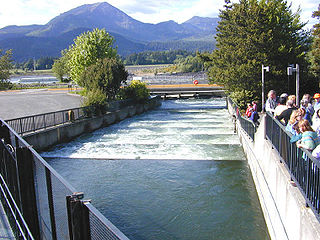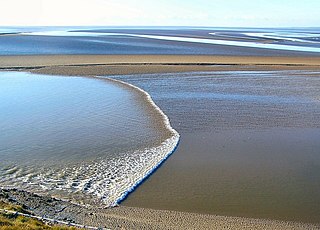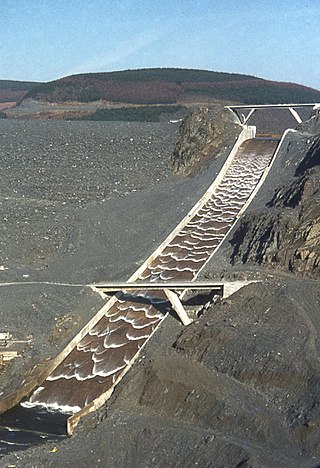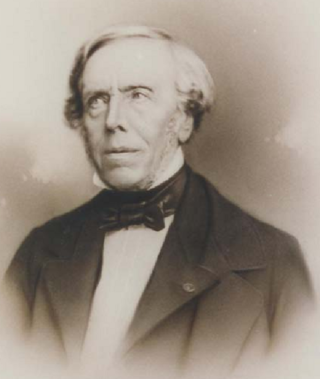Flow measurement is the quantification of bulk fluid movement. Flow can be measured using devices called flowmeters in various ways. The common types of flowmeters with industrial applications are listed below:

A weir or low-head dam is a barrier across the width of a river that alters the flow characteristics of water and usually results in a change in the height of the river level. Weirs are also used to control the flow of water for outlets of lakes, ponds, and reservoirs. There are many weir designs, but commonly water flows freely over the top of the weir crest before cascading down to a lower level. There is no single definition as to what constitutes a weir, and one English dictionary simply defines a weir as a small dam.

A fish ladder, also known as a fishway, fish pass, fish steps, or fish cannon is a structure on or around artificial and natural barriers to facilitate diadromous fishes' natural migration as well as movements of potamodromous species. Most fishways enable fish to pass around the barriers by swimming and leaping up a series of relatively low steps into the waters on the other side. The velocity of water falling over the steps has to be great enough to attract the fish to the ladder, but it cannot be so great that it washes fish back downstream or exhausts them to the point of inability to continue their journey upriver.

A tidal bore, often simply given as bore in context, is a tidal phenomenon in which the leading edge of the incoming tide forms a wave of water that travels up a river or narrow bay, reversing the direction of the river or bay's current. It is a strong tide that pushes up the river, against the current.

A spillway is a structure used to provide the controlled release of water downstream from a dam or levee, typically into the riverbed of the dammed river itself. In the United Kingdom, they may be known as overflow channels. Spillways ensure that water does not damage parts of the structure not designed to convey water.

Laser Doppler velocimetry, also known as laser Doppler anemometry, is the technique of using the Doppler shift in a laser beam to measure the velocity in transparent or semi-transparent fluid flows or the linear or vibratory motion of opaque, reflecting surfaces. The measurement with laser Doppler anemometry is absolute and linear with velocity and requires no pre-calibration.

Frazil ice is a collection of loose, randomly oriented ice crystals millimeter and sub-millimeter in size, with various shapes, e.g. elliptical disks, dendrites, needles and of an irregular nature. Frazil ice forms during the winter in open-water reaches of rivers as well as in lakes and reservoirs, where and when the water is in a turbulent state, which is, in turn, induced by the action of waves and currents. Turbulence causes the water column to become supercooled, as the heat exchange between the air and the water is such that the water temperature drops below its freezing point. The vertical mixing associated with that turbulence provides enough energy to overcome the crystals' buoyancy, thus keeping them from floating at the surface. Frazil ice also forms in oceans, where windy conditions, wave regimes and cold air also favor the establishment of a supercooled layer. Frazil ice can be found on the downwind side of leads, and in polynyas. In these environments, that ice can eventually accumulate at the water surface into what is referred to as grease ice.

A culvert is a structure that channels water past an obstacle or to a subterranean waterway. Typically embedded so as to be surrounded by soil, a culvert may be made from a pipe, reinforced concrete or other material. In the United Kingdom, the word can also be used for a longer artificially buried watercourse.
Hunter Rouse was a hydraulician known for his research on the mechanics of fluid turbulence.

Velocimetry is the measurement of the velocity of fluids. This is a task often taken for granted, and involves far more complex processes than one might expect. It is often used to solve fluid dynamics problems, study fluid networks, in industrial and process control applications, as well as in the creation of new kinds of fluid flow sensors. Methods of velocimetry include particle image velocimetry and particle tracking velocimetry, Molecular tagging velocimetry, laser-based interferometry, ultrasonic Doppler methods, Doppler sensors, and new signal processing methodologies.
An acoustic doppler current profiler (ADCP) is a hydroacoustic current meter similar to a sonar, used to measure water current velocities over a depth range using the Doppler effect of sound waves scattered back from particles within the water column. The term ADCP is a generic term for all acoustic current profilers, although the abbreviation originates from an instrument series introduced by RD Instruments in the 1980s. The working frequencies range of ADCPs range from 38 kHz to several megahertz.

A low-water crossing is a low-elevation roadway traversing over a waterbody that stays dry above the water when the flow is low, but is designed to get submerged under high-flow conditions such as floods. This type of crossing is much cheaper to build than a high bridge that keeps the road surface consistently above the highest water level, and is usually deployed in semi-arid areas where high-volume rainfall is rare and the existing channel is shallow, particularly in developing countries.
Training or entrance training refers to coastal structures built to constrain a river discharging across a littoral coast so that it discharges only where desired. Untrained entrances on sandy coasts tend to move widely and violently to discharge into the ocean, often upsetting those enjoying land nearby. With many cities constructed close to rivers, such management has historically been considered a necessary course of action, even though ecologically, non-intervention would be better and more sustainable.

Jean-Baptiste Charles Joseph Bélanger was a French applied mathematician who worked in the areas of hydraulics and hydrodynamics. He was a professor at the École Centrale des Arts et Manufactures, École Polytechnique and École des Ponts et Chaussées in France. In hydraulic engineering, he is often credited improperly for the application of the momentum principle to a hydraulic jump in a rectangular open channel in 1828. His true contribution in 1828 was the development of the backwater equation for gradually varied flows in open channels and the application of the momentum principle to the hydraulic jump flow in 1838.
Wash load is similar to a suspended load, but wash load sediment never interacts with the bed load. All of the sediment in the wash load stays suspended in the water throughout the channel. Wash load refers to a river's ability to move sediment through a channel.

Hubert Chanson is a professional engineer and academic in hydraulic engineering and environmental fluid mechanics. Since 1990 he has worked at the University of Queensland.
Three components that are included in the load of a river system are the following: dissolved load, wash load and bed material load. The bed material load is the portion of the sediment that is transported by a stream that contains material derived from the bed. Bed material load typically consists of all of the bed load, and the proportion of the suspended load that is represented in the bed sediments. It generally consists of grains coarser than 0.062 mm with the principal source being the channel bed. Its importance lies in that its composition is that of the bed, and the material in transport can therefore be actively interchanged with the bed. For this reason, bed material load exerts a control on river channel morphology. Bed load and wash load together constitute the total load of sediment in a stream. The order in which the three components of load have been considered – dissolved, wash, bed material – can be thought of as progression: of increasingly slower transport velocities, so that the load peak lags further and further behind the flow peak during any event.
Eprapah Creek is a sub-tropical stream in Redland City close to Brisbane in South East Queensland, Australia.

A stepped spillway is a spillway with steps on the spillway chute to assist in the dissipation of the kinetic energy of the descending water. This eliminates or reduces the need for an additional energy dissipator, such as a body of water, at the end of the spillway downstream.

Jørgen Fredsøe (1947) is a Danish hydraulic engineer who is recognized for his contributions within bed form dynamics in rivers and the marine environment and coastal morphology including bars and beach undulations. Together with professor B. Mutlu Sumer he initiated the research on scour (erosion) in the seabed around coastal structures applying detailed hydrodynamic interpretations. He was born in Randers, Denmark.












